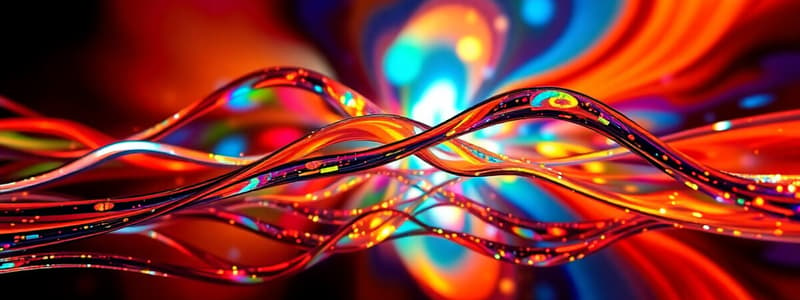Podcast
Questions and Answers
Which theory best explains the phenomenon of dispersion of light?
Which theory best explains the phenomenon of dispersion of light?
- Newton's Theory
- Special Relativity
- Corpuscular Theory
- Wave Theory (correct)
What is the primary difference between wave theory and particle theory of light?
What is the primary difference between wave theory and particle theory of light?
- Particle theory focuses on photons while wave theory refers to energy waves. (correct)
- Particle theory explains reflection while wave theory does not.
- Wave theory can explain diffraction while particle theory cannot.
- Wave theory requires a medium while particle theory does not.
Which statement is true about the laws of reflection?
Which statement is true about the laws of reflection?
- The incident ray and the reflected ray travel in opposite directions.
- The angle of incidence is greater than the angle of reflection.
- The angle of reflection is always zero.
- The incident ray, reflected ray, and normal lie in the same plane. (correct)
Which of the following phenomena cannot be explained by wave theory?
Which of the following phenomena cannot be explained by wave theory?
What characteristic of microwaves differentiates them from visible light?
What characteristic of microwaves differentiates them from visible light?
Flashcards
Light's Wave Nature
Light's Wave Nature
Light travels as a transverse wave, not needing a material to move through.
Light's Particle Nature
Light's Particle Nature
Light consists of tiny packets of energy called photons.
Dual Nature of Light
Dual Nature of Light
Light acts like both waves and particles in different situations.
Law of Reflection (Angle)
Law of Reflection (Angle)
Signup and view all the flashcards
Microwave Energy
Microwave Energy
Signup and view all the flashcards
Study Notes
Light and its Nature
- Light is a form of energy that allows us to see objects.
- Objects reflect light that falls on them.
- Light does not require a medium to travel.
- Light is a transverse wave.
- Wave nature of light is explained by Huygen's theory.
- The particle nature of light is explained by the Corpuscular theory.
- Quantum theory treats light as packets or bundles of energy (photons).
- Light exhibits both wave-like and particle-like properties.
Laws of Reflection
- Light reflects according to the laws of reflection.
- The angle of incidence equals the angle of reflection.
- The incident ray, the reflected ray, and the normal all lie in the same plane.
Studying That Suits You
Use AI to generate personalized quizzes and flashcards to suit your learning preferences.




